Project Development and Optimization - Assignment PDF
VerifiedAdded on 2021/05/31
|18
|4577
|23
AI Summary
Contribute Materials
Your contribution can guide someone’s learning journey. Share your
documents today.
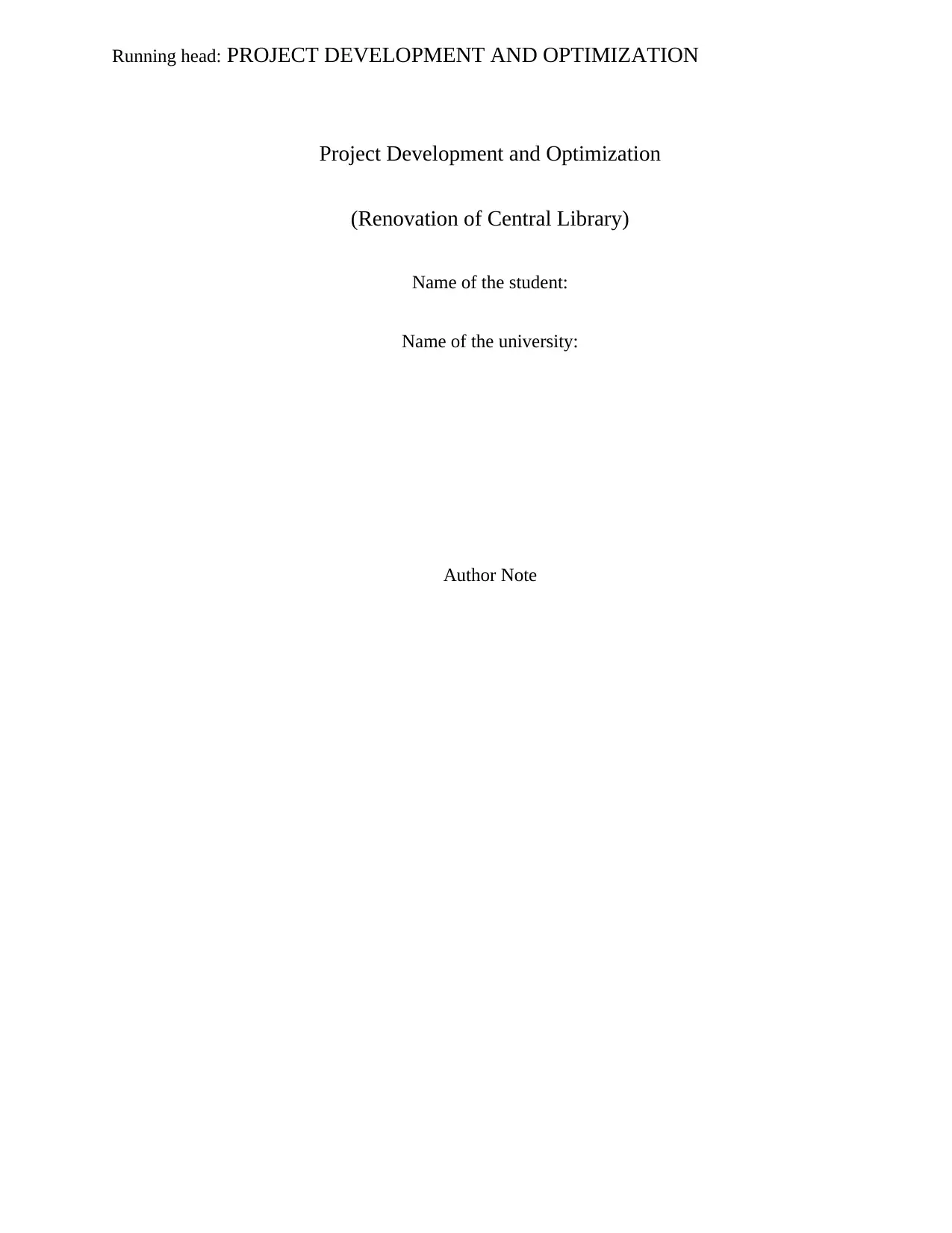
Running head: PROJECT DEVELOPMENT AND OPTIMIZATION
Project Development and Optimization
(Renovation of Central Library)
Name of the student:
Name of the university:
Author Note
Project Development and Optimization
(Renovation of Central Library)
Name of the student:
Name of the university:
Author Note
Secure Best Marks with AI Grader
Need help grading? Try our AI Grader for instant feedback on your assignments.
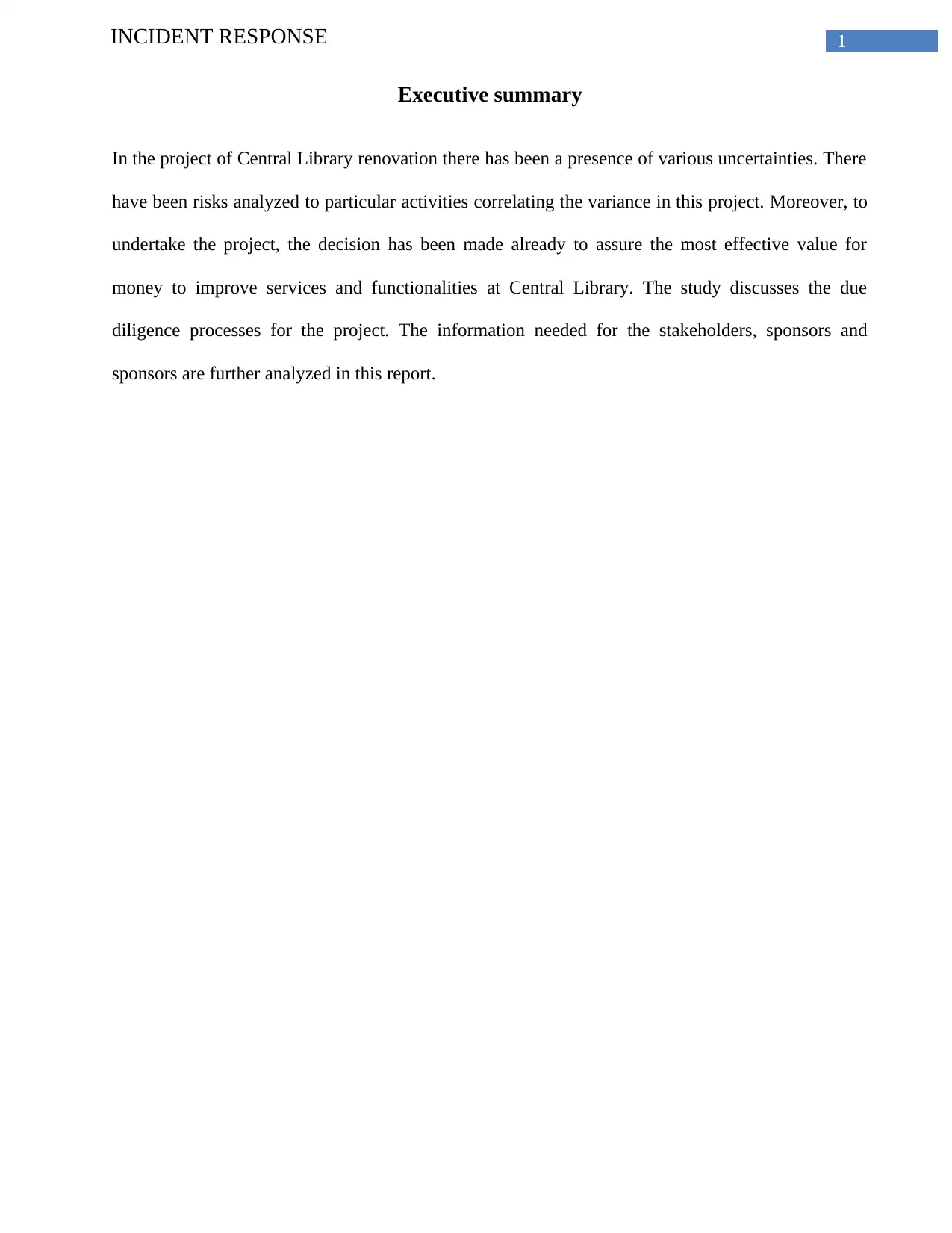
1INCIDENT RESPONSE
Executive summary
In the project of Central Library renovation there has been a presence of various uncertainties. There
have been risks analyzed to particular activities correlating the variance in this project. Moreover, to
undertake the project, the decision has been made already to assure the most effective value for
money to improve services and functionalities at Central Library. The study discusses the due
diligence processes for the project. The information needed for the stakeholders, sponsors and
sponsors are further analyzed in this report.
Executive summary
In the project of Central Library renovation there has been a presence of various uncertainties. There
have been risks analyzed to particular activities correlating the variance in this project. Moreover, to
undertake the project, the decision has been made already to assure the most effective value for
money to improve services and functionalities at Central Library. The study discusses the due
diligence processes for the project. The information needed for the stakeholders, sponsors and
sponsors are further analyzed in this report.
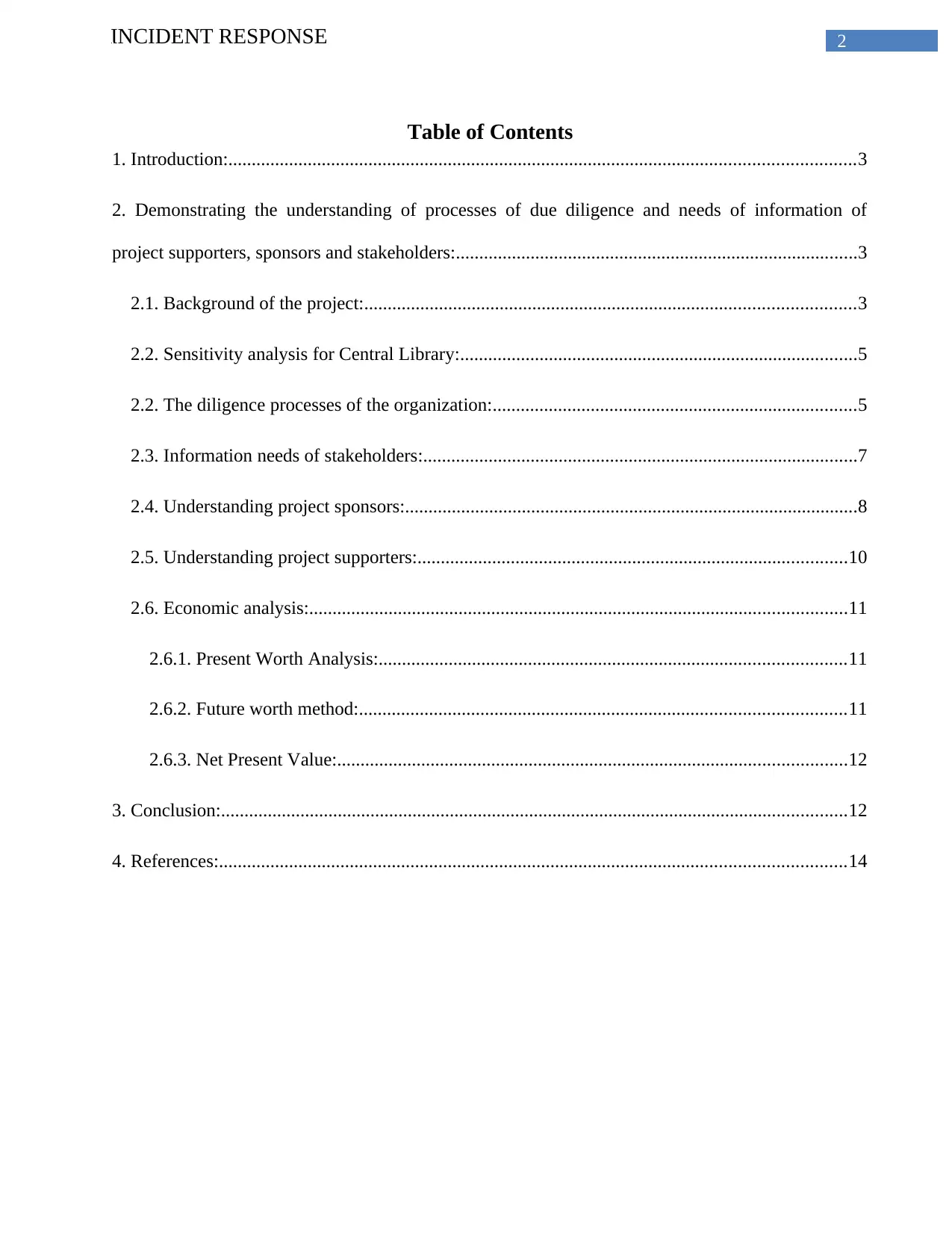
2INCIDENT RESPONSE
Table of Contents
1. Introduction:......................................................................................................................................3
2. Demonstrating the understanding of processes of due diligence and needs of information of
project supporters, sponsors and stakeholders:......................................................................................3
2.1. Background of the project:.........................................................................................................3
2.2. Sensitivity analysis for Central Library:.....................................................................................5
2.2. The diligence processes of the organization:..............................................................................5
2.3. Information needs of stakeholders:.............................................................................................7
2.4. Understanding project sponsors:.................................................................................................8
2.5. Understanding project supporters:............................................................................................10
2.6. Economic analysis:...................................................................................................................11
2.6.1. Present Worth Analysis:....................................................................................................11
2.6.2. Future worth method:........................................................................................................11
2.6.3. Net Present Value:.............................................................................................................12
3. Conclusion:......................................................................................................................................12
4. References:......................................................................................................................................14
Table of Contents
1. Introduction:......................................................................................................................................3
2. Demonstrating the understanding of processes of due diligence and needs of information of
project supporters, sponsors and stakeholders:......................................................................................3
2.1. Background of the project:.........................................................................................................3
2.2. Sensitivity analysis for Central Library:.....................................................................................5
2.2. The diligence processes of the organization:..............................................................................5
2.3. Information needs of stakeholders:.............................................................................................7
2.4. Understanding project sponsors:.................................................................................................8
2.5. Understanding project supporters:............................................................................................10
2.6. Economic analysis:...................................................................................................................11
2.6.1. Present Worth Analysis:....................................................................................................11
2.6.2. Future worth method:........................................................................................................11
2.6.3. Net Present Value:.............................................................................................................12
3. Conclusion:......................................................................................................................................12
4. References:......................................................................................................................................14

3INCIDENT RESPONSE
Secure Best Marks with AI Grader
Need help grading? Try our AI Grader for instant feedback on your assignments.
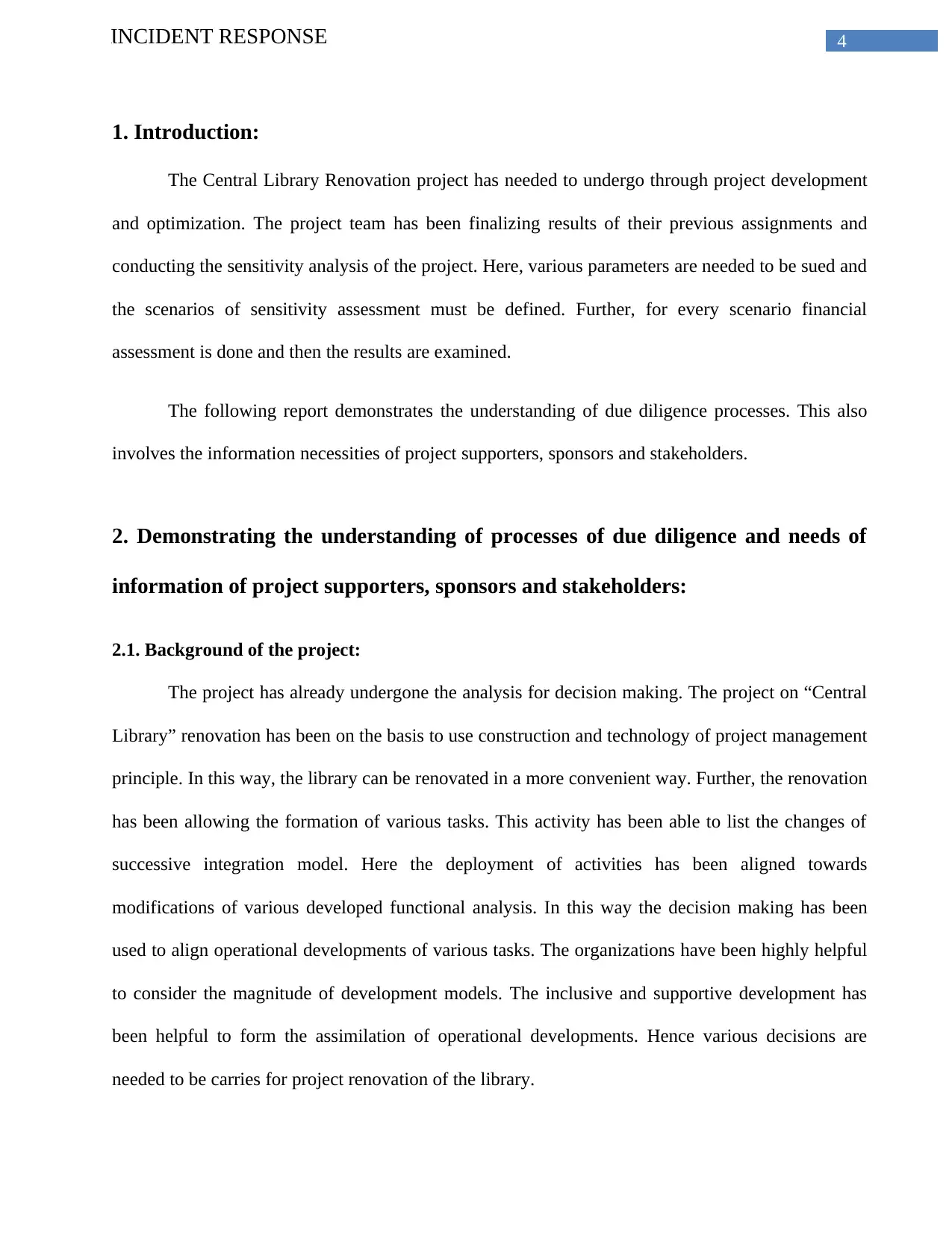
4INCIDENT RESPONSE
1. Introduction:
The Central Library Renovation project has needed to undergo through project development
and optimization. The project team has been finalizing results of their previous assignments and
conducting the sensitivity analysis of the project. Here, various parameters are needed to be sued and
the scenarios of sensitivity assessment must be defined. Further, for every scenario financial
assessment is done and then the results are examined.
The following report demonstrates the understanding of due diligence processes. This also
involves the information necessities of project supporters, sponsors and stakeholders.
2. Demonstrating the understanding of processes of due diligence and needs of
information of project supporters, sponsors and stakeholders:
2.1. Background of the project:
The project has already undergone the analysis for decision making. The project on “Central
Library” renovation has been on the basis to use construction and technology of project management
principle. In this way, the library can be renovated in a more convenient way. Further, the renovation
has been allowing the formation of various tasks. This activity has been able to list the changes of
successive integration model. Here the deployment of activities has been aligned towards
modifications of various developed functional analysis. In this way the decision making has been
used to align operational developments of various tasks. The organizations have been highly helpful
to consider the magnitude of development models. The inclusive and supportive development has
been helpful to form the assimilation of operational developments. Hence various decisions are
needed to be carries for project renovation of the library.
1. Introduction:
The Central Library Renovation project has needed to undergo through project development
and optimization. The project team has been finalizing results of their previous assignments and
conducting the sensitivity analysis of the project. Here, various parameters are needed to be sued and
the scenarios of sensitivity assessment must be defined. Further, for every scenario financial
assessment is done and then the results are examined.
The following report demonstrates the understanding of due diligence processes. This also
involves the information necessities of project supporters, sponsors and stakeholders.
2. Demonstrating the understanding of processes of due diligence and needs of
information of project supporters, sponsors and stakeholders:
2.1. Background of the project:
The project has already undergone the analysis for decision making. The project on “Central
Library” renovation has been on the basis to use construction and technology of project management
principle. In this way, the library can be renovated in a more convenient way. Further, the renovation
has been allowing the formation of various tasks. This activity has been able to list the changes of
successive integration model. Here the deployment of activities has been aligned towards
modifications of various developed functional analysis. In this way the decision making has been
used to align operational developments of various tasks. The organizations have been highly helpful
to consider the magnitude of development models. The inclusive and supportive development has
been helpful to form the assimilation of operational developments. Hence various decisions are
needed to be carries for project renovation of the library.
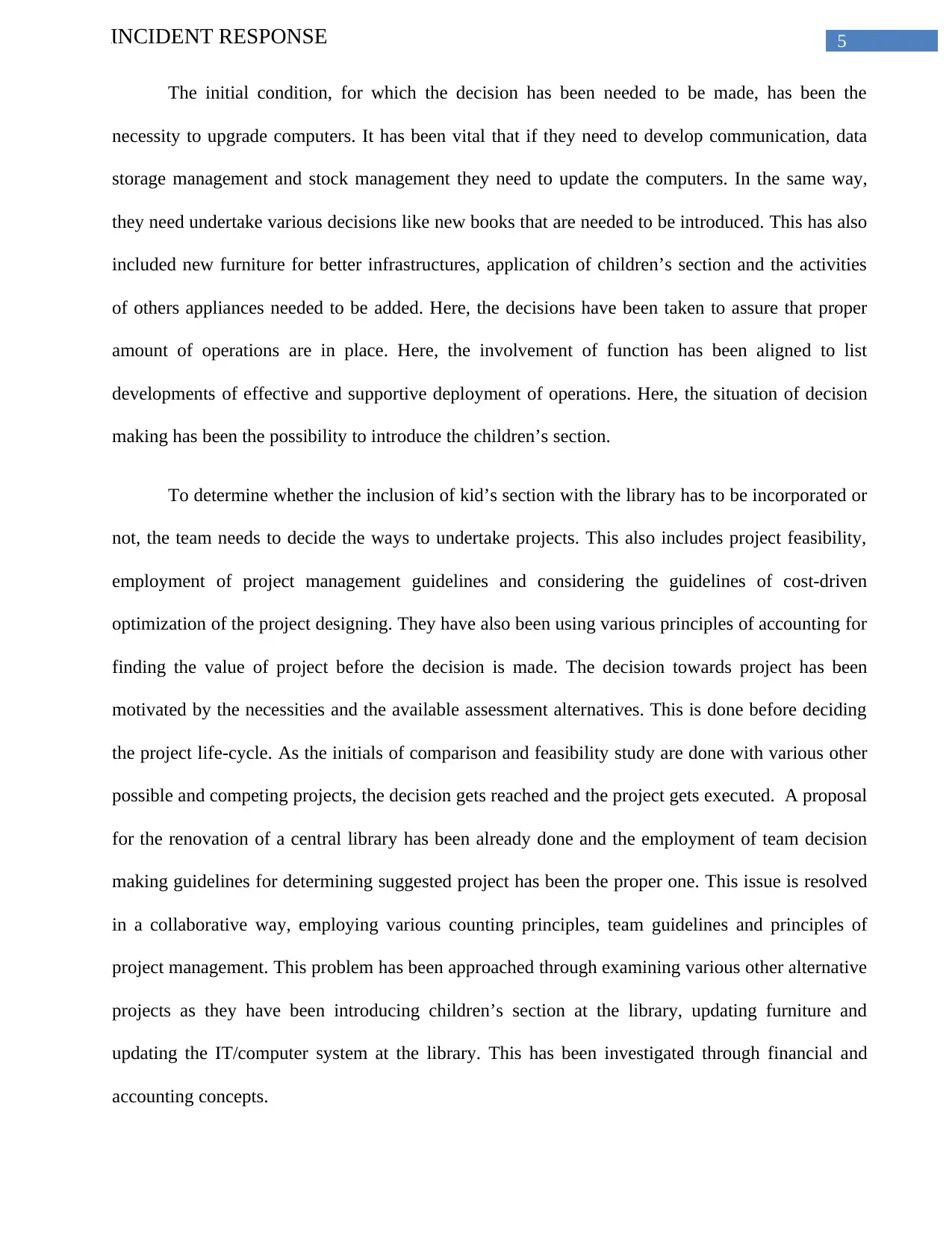
5INCIDENT RESPONSE
The initial condition, for which the decision has been needed to be made, has been the
necessity to upgrade computers. It has been vital that if they need to develop communication, data
storage management and stock management they need to update the computers. In the same way,
they need undertake various decisions like new books that are needed to be introduced. This has also
included new furniture for better infrastructures, application of children’s section and the activities
of others appliances needed to be added. Here, the decisions have been taken to assure that proper
amount of operations are in place. Here, the involvement of function has been aligned to list
developments of effective and supportive deployment of operations. Here, the situation of decision
making has been the possibility to introduce the children’s section.
To determine whether the inclusion of kid’s section with the library has to be incorporated or
not, the team needs to decide the ways to undertake projects. This also includes project feasibility,
employment of project management guidelines and considering the guidelines of cost-driven
optimization of the project designing. They have also been using various principles of accounting for
finding the value of project before the decision is made. The decision towards project has been
motivated by the necessities and the available assessment alternatives. This is done before deciding
the project life-cycle. As the initials of comparison and feasibility study are done with various other
possible and competing projects, the decision gets reached and the project gets executed. A proposal
for the renovation of a central library has been already done and the employment of team decision
making guidelines for determining suggested project has been the proper one. This issue is resolved
in a collaborative way, employing various counting principles, team guidelines and principles of
project management. This problem has been approached through examining various other alternative
projects as they have been introducing children’s section at the library, updating furniture and
updating the IT/computer system at the library. This has been investigated through financial and
accounting concepts.
The initial condition, for which the decision has been needed to be made, has been the
necessity to upgrade computers. It has been vital that if they need to develop communication, data
storage management and stock management they need to update the computers. In the same way,
they need undertake various decisions like new books that are needed to be introduced. This has also
included new furniture for better infrastructures, application of children’s section and the activities
of others appliances needed to be added. Here, the decisions have been taken to assure that proper
amount of operations are in place. Here, the involvement of function has been aligned to list
developments of effective and supportive deployment of operations. Here, the situation of decision
making has been the possibility to introduce the children’s section.
To determine whether the inclusion of kid’s section with the library has to be incorporated or
not, the team needs to decide the ways to undertake projects. This also includes project feasibility,
employment of project management guidelines and considering the guidelines of cost-driven
optimization of the project designing. They have also been using various principles of accounting for
finding the value of project before the decision is made. The decision towards project has been
motivated by the necessities and the available assessment alternatives. This is done before deciding
the project life-cycle. As the initials of comparison and feasibility study are done with various other
possible and competing projects, the decision gets reached and the project gets executed. A proposal
for the renovation of a central library has been already done and the employment of team decision
making guidelines for determining suggested project has been the proper one. This issue is resolved
in a collaborative way, employing various counting principles, team guidelines and principles of
project management. This problem has been approached through examining various other alternative
projects as they have been introducing children’s section at the library, updating furniture and
updating the IT/computer system at the library. This has been investigated through financial and
accounting concepts.
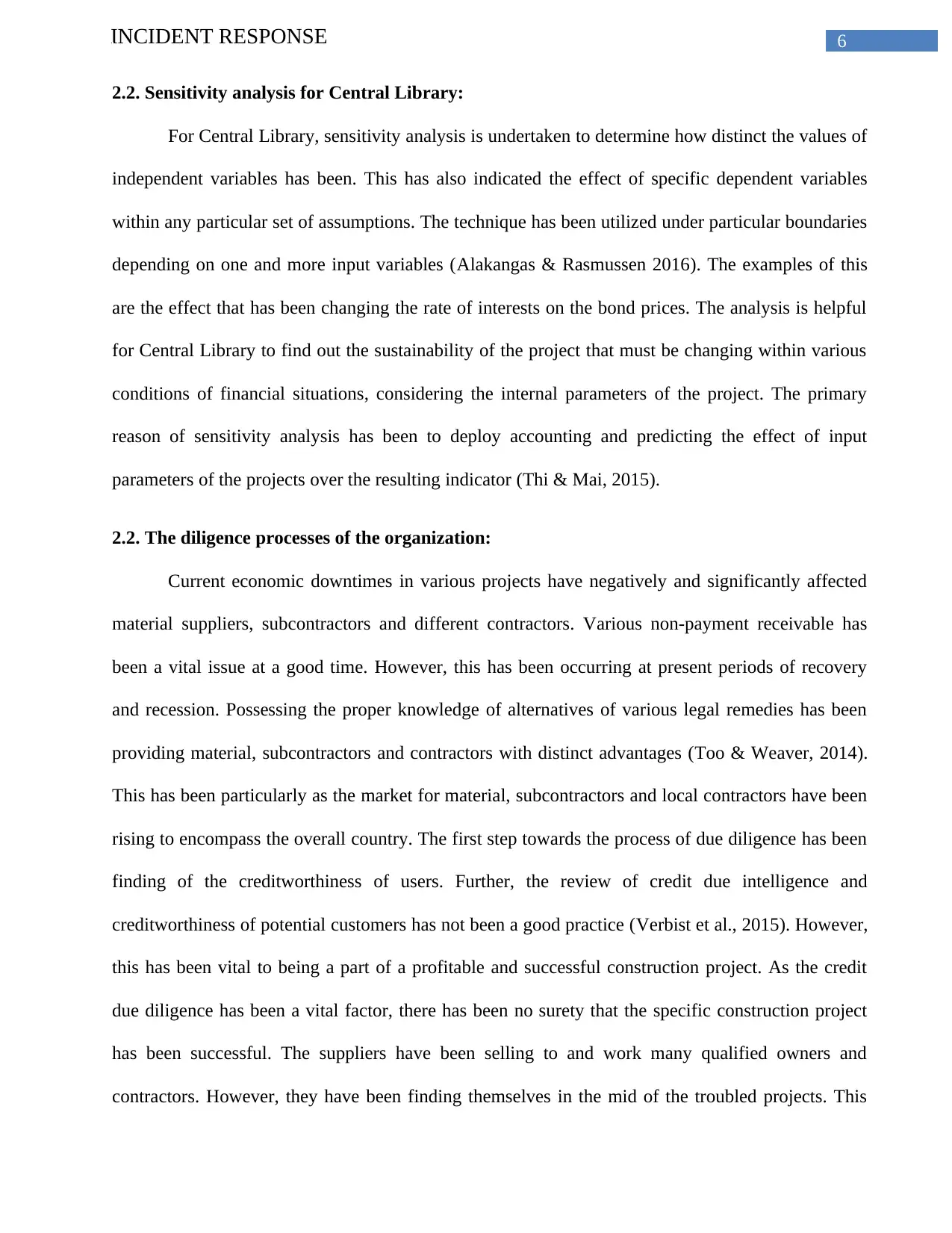
6INCIDENT RESPONSE
2.2. Sensitivity analysis for Central Library:
For Central Library, sensitivity analysis is undertaken to determine how distinct the values of
independent variables has been. This has also indicated the effect of specific dependent variables
within any particular set of assumptions. The technique has been utilized under particular boundaries
depending on one and more input variables (Alakangas & Rasmussen 2016). The examples of this
are the effect that has been changing the rate of interests on the bond prices. The analysis is helpful
for Central Library to find out the sustainability of the project that must be changing within various
conditions of financial situations, considering the internal parameters of the project. The primary
reason of sensitivity analysis has been to deploy accounting and predicting the effect of input
parameters of the projects over the resulting indicator (Thi & Mai, 2015).
2.2. The diligence processes of the organization:
Current economic downtimes in various projects have negatively and significantly affected
material suppliers, subcontractors and different contractors. Various non-payment receivable has
been a vital issue at a good time. However, this has been occurring at present periods of recovery
and recession. Possessing the proper knowledge of alternatives of various legal remedies has been
providing material, subcontractors and contractors with distinct advantages (Too & Weaver, 2014).
This has been particularly as the market for material, subcontractors and local contractors have been
rising to encompass the overall country. The first step towards the process of due diligence has been
finding of the creditworthiness of users. Further, the review of credit due intelligence and
creditworthiness of potential customers has not been a good practice (Verbist et al., 2015). However,
this has been vital to being a part of a profitable and successful construction project. As the credit
due diligence has been a vital factor, there has been no surety that the specific construction project
has been successful. The suppliers have been selling to and work many qualified owners and
contractors. However, they have been finding themselves in the mid of the troubled projects. This
2.2. Sensitivity analysis for Central Library:
For Central Library, sensitivity analysis is undertaken to determine how distinct the values of
independent variables has been. This has also indicated the effect of specific dependent variables
within any particular set of assumptions. The technique has been utilized under particular boundaries
depending on one and more input variables (Alakangas & Rasmussen 2016). The examples of this
are the effect that has been changing the rate of interests on the bond prices. The analysis is helpful
for Central Library to find out the sustainability of the project that must be changing within various
conditions of financial situations, considering the internal parameters of the project. The primary
reason of sensitivity analysis has been to deploy accounting and predicting the effect of input
parameters of the projects over the resulting indicator (Thi & Mai, 2015).
2.2. The diligence processes of the organization:
Current economic downtimes in various projects have negatively and significantly affected
material suppliers, subcontractors and different contractors. Various non-payment receivable has
been a vital issue at a good time. However, this has been occurring at present periods of recovery
and recession. Possessing the proper knowledge of alternatives of various legal remedies has been
providing material, subcontractors and contractors with distinct advantages (Too & Weaver, 2014).
This has been particularly as the market for material, subcontractors and local contractors have been
rising to encompass the overall country. The first step towards the process of due diligence has been
finding of the creditworthiness of users. Further, the review of credit due intelligence and
creditworthiness of potential customers has not been a good practice (Verbist et al., 2015). However,
this has been vital to being a part of a profitable and successful construction project. As the credit
due diligence has been a vital factor, there has been no surety that the specific construction project
has been successful. The suppliers have been selling to and work many qualified owners and
contractors. However, they have been finding themselves in the mid of the troubled projects. This
Paraphrase This Document
Need a fresh take? Get an instant paraphrase of this document with our AI Paraphraser
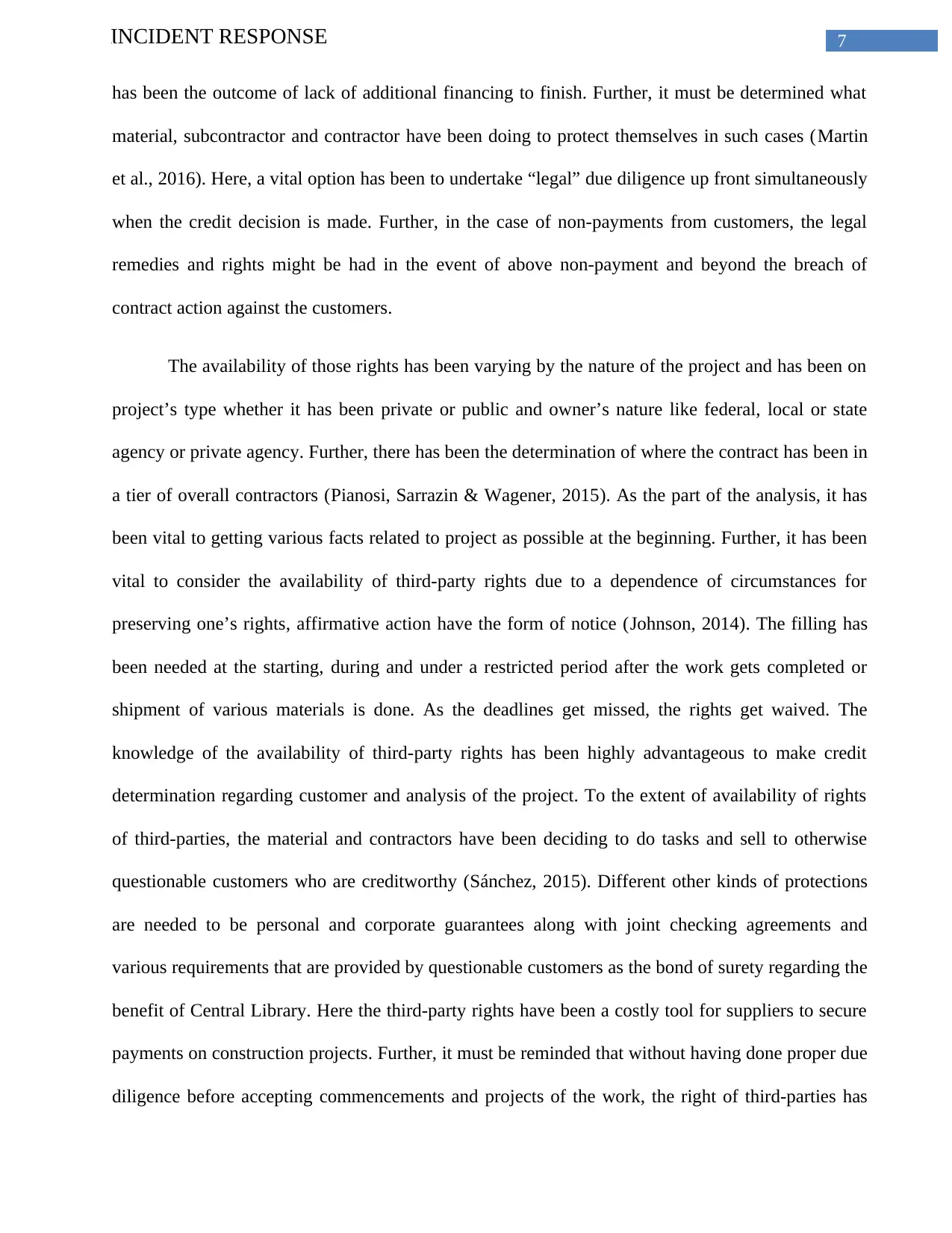
7INCIDENT RESPONSE
has been the outcome of lack of additional financing to finish. Further, it must be determined what
material, subcontractor and contractor have been doing to protect themselves in such cases (Martin
et al., 2016). Here, a vital option has been to undertake “legal” due diligence up front simultaneously
when the credit decision is made. Further, in the case of non-payments from customers, the legal
remedies and rights might be had in the event of above non-payment and beyond the breach of
contract action against the customers.
The availability of those rights has been varying by the nature of the project and has been on
project’s type whether it has been private or public and owner’s nature like federal, local or state
agency or private agency. Further, there has been the determination of where the contract has been in
a tier of overall contractors (Pianosi, Sarrazin & Wagener, 2015). As the part of the analysis, it has
been vital to getting various facts related to project as possible at the beginning. Further, it has been
vital to consider the availability of third-party rights due to a dependence of circumstances for
preserving one’s rights, affirmative action have the form of notice (Johnson, 2014). The filling has
been needed at the starting, during and under a restricted period after the work gets completed or
shipment of various materials is done. As the deadlines get missed, the rights get waived. The
knowledge of the availability of third-party rights has been highly advantageous to make credit
determination regarding customer and analysis of the project. To the extent of availability of rights
of third-parties, the material and contractors have been deciding to do tasks and sell to otherwise
questionable customers who are creditworthy (Sánchez, 2015). Different other kinds of protections
are needed to be personal and corporate guarantees along with joint checking agreements and
various requirements that are provided by questionable customers as the bond of surety regarding the
benefit of Central Library. Here the third-party rights have been a costly tool for suppliers to secure
payments on construction projects. Further, it must be reminded that without having done proper due
diligence before accepting commencements and projects of the work, the right of third-parties has
has been the outcome of lack of additional financing to finish. Further, it must be determined what
material, subcontractor and contractor have been doing to protect themselves in such cases (Martin
et al., 2016). Here, a vital option has been to undertake “legal” due diligence up front simultaneously
when the credit decision is made. Further, in the case of non-payments from customers, the legal
remedies and rights might be had in the event of above non-payment and beyond the breach of
contract action against the customers.
The availability of those rights has been varying by the nature of the project and has been on
project’s type whether it has been private or public and owner’s nature like federal, local or state
agency or private agency. Further, there has been the determination of where the contract has been in
a tier of overall contractors (Pianosi, Sarrazin & Wagener, 2015). As the part of the analysis, it has
been vital to getting various facts related to project as possible at the beginning. Further, it has been
vital to consider the availability of third-party rights due to a dependence of circumstances for
preserving one’s rights, affirmative action have the form of notice (Johnson, 2014). The filling has
been needed at the starting, during and under a restricted period after the work gets completed or
shipment of various materials is done. As the deadlines get missed, the rights get waived. The
knowledge of the availability of third-party rights has been highly advantageous to make credit
determination regarding customer and analysis of the project. To the extent of availability of rights
of third-parties, the material and contractors have been deciding to do tasks and sell to otherwise
questionable customers who are creditworthy (Sánchez, 2015). Different other kinds of protections
are needed to be personal and corporate guarantees along with joint checking agreements and
various requirements that are provided by questionable customers as the bond of surety regarding the
benefit of Central Library. Here the third-party rights have been a costly tool for suppliers to secure
payments on construction projects. Further, it must be reminded that without having done proper due
diligence before accepting commencements and projects of the work, the right of third-parties has
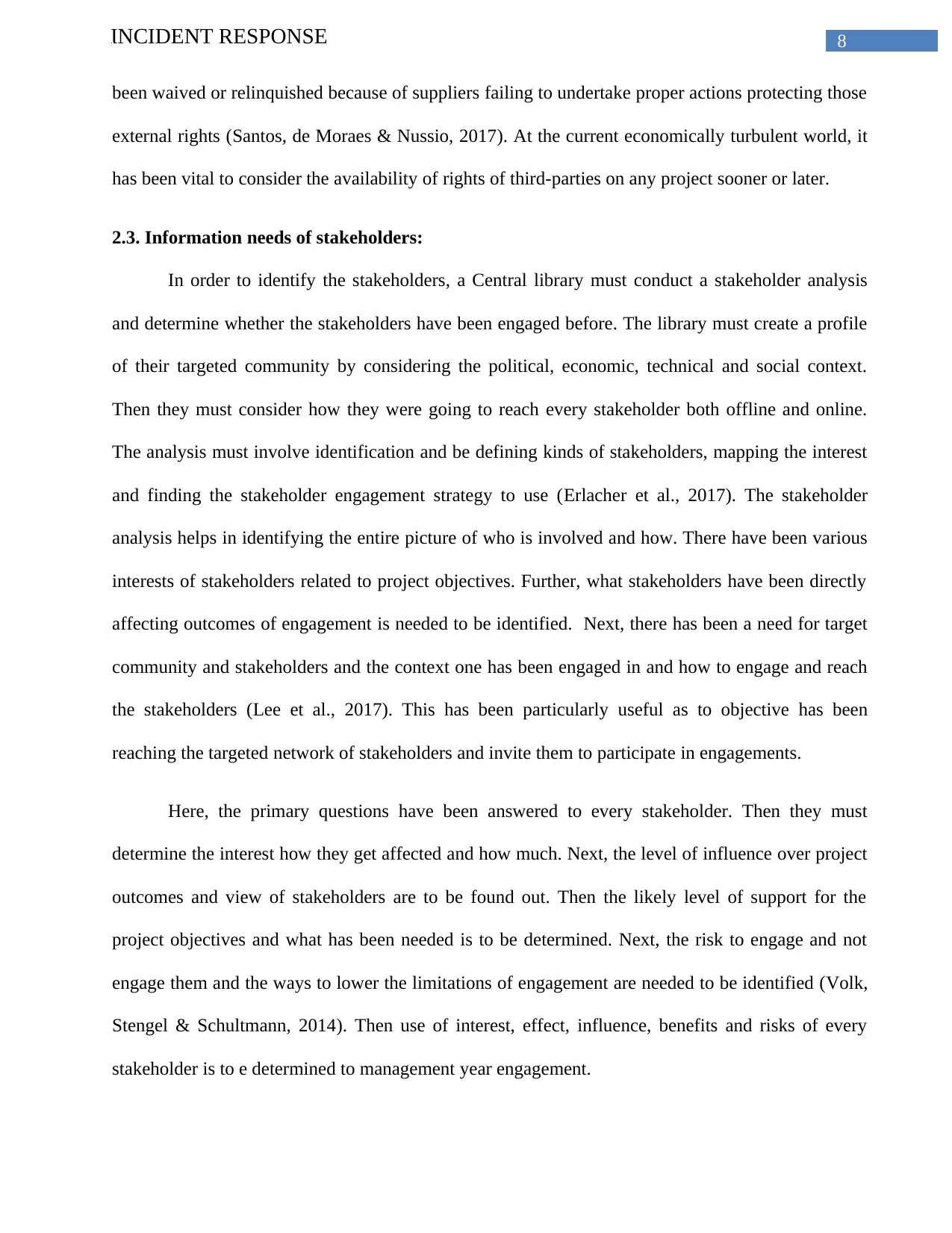
8INCIDENT RESPONSE
been waived or relinquished because of suppliers failing to undertake proper actions protecting those
external rights (Santos, de Moraes & Nussio, 2017). At the current economically turbulent world, it
has been vital to consider the availability of rights of third-parties on any project sooner or later.
2.3. Information needs of stakeholders:
In order to identify the stakeholders, a Central library must conduct a stakeholder analysis
and determine whether the stakeholders have been engaged before. The library must create a profile
of their targeted community by considering the political, economic, technical and social context.
Then they must consider how they were going to reach every stakeholder both offline and online.
The analysis must involve identification and be defining kinds of stakeholders, mapping the interest
and finding the stakeholder engagement strategy to use (Erlacher et al., 2017). The stakeholder
analysis helps in identifying the entire picture of who is involved and how. There have been various
interests of stakeholders related to project objectives. Further, what stakeholders have been directly
affecting outcomes of engagement is needed to be identified. Next, there has been a need for target
community and stakeholders and the context one has been engaged in and how to engage and reach
the stakeholders (Lee et al., 2017). This has been particularly useful as to objective has been
reaching the targeted network of stakeholders and invite them to participate in engagements.
Here, the primary questions have been answered to every stakeholder. Then they must
determine the interest how they get affected and how much. Next, the level of influence over project
outcomes and view of stakeholders are to be found out. Then the likely level of support for the
project objectives and what has been needed is to be determined. Next, the risk to engage and not
engage them and the ways to lower the limitations of engagement are needed to be identified (Volk,
Stengel & Schultmann, 2014). Then use of interest, effect, influence, benefits and risks of every
stakeholder is to e determined to management year engagement.
been waived or relinquished because of suppliers failing to undertake proper actions protecting those
external rights (Santos, de Moraes & Nussio, 2017). At the current economically turbulent world, it
has been vital to consider the availability of rights of third-parties on any project sooner or later.
2.3. Information needs of stakeholders:
In order to identify the stakeholders, a Central library must conduct a stakeholder analysis
and determine whether the stakeholders have been engaged before. The library must create a profile
of their targeted community by considering the political, economic, technical and social context.
Then they must consider how they were going to reach every stakeholder both offline and online.
The analysis must involve identification and be defining kinds of stakeholders, mapping the interest
and finding the stakeholder engagement strategy to use (Erlacher et al., 2017). The stakeholder
analysis helps in identifying the entire picture of who is involved and how. There have been various
interests of stakeholders related to project objectives. Further, what stakeholders have been directly
affecting outcomes of engagement is needed to be identified. Next, there has been a need for target
community and stakeholders and the context one has been engaged in and how to engage and reach
the stakeholders (Lee et al., 2017). This has been particularly useful as to objective has been
reaching the targeted network of stakeholders and invite them to participate in engagements.
Here, the primary questions have been answered to every stakeholder. Then they must
determine the interest how they get affected and how much. Next, the level of influence over project
outcomes and view of stakeholders are to be found out. Then the likely level of support for the
project objectives and what has been needed is to be determined. Next, the risk to engage and not
engage them and the ways to lower the limitations of engagement are needed to be identified (Volk,
Stengel & Schultmann, 2014). Then use of interest, effect, influence, benefits and risks of every
stakeholder is to e determined to management year engagement.
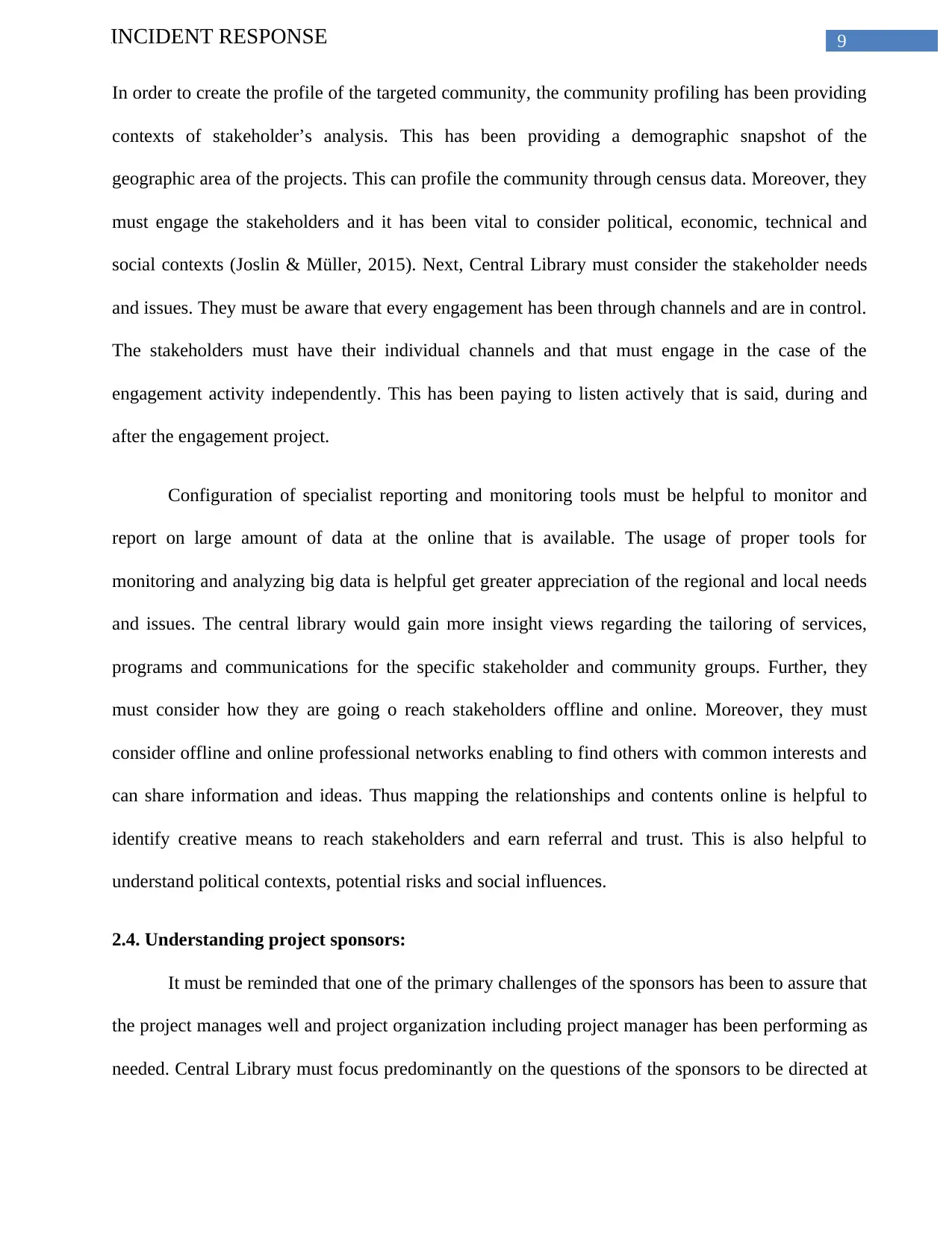
9INCIDENT RESPONSE
In order to create the profile of the targeted community, the community profiling has been providing
contexts of stakeholder’s analysis. This has been providing a demographic snapshot of the
geographic area of the projects. This can profile the community through census data. Moreover, they
must engage the stakeholders and it has been vital to consider political, economic, technical and
social contexts (Joslin & Müller, 2015). Next, Central Library must consider the stakeholder needs
and issues. They must be aware that every engagement has been through channels and are in control.
The stakeholders must have their individual channels and that must engage in the case of the
engagement activity independently. This has been paying to listen actively that is said, during and
after the engagement project.
Configuration of specialist reporting and monitoring tools must be helpful to monitor and
report on large amount of data at the online that is available. The usage of proper tools for
monitoring and analyzing big data is helpful get greater appreciation of the regional and local needs
and issues. The central library would gain more insight views regarding the tailoring of services,
programs and communications for the specific stakeholder and community groups. Further, they
must consider how they are going o reach stakeholders offline and online. Moreover, they must
consider offline and online professional networks enabling to find others with common interests and
can share information and ideas. Thus mapping the relationships and contents online is helpful to
identify creative means to reach stakeholders and earn referral and trust. This is also helpful to
understand political contexts, potential risks and social influences.
2.4. Understanding project sponsors:
It must be reminded that one of the primary challenges of the sponsors has been to assure that
the project manages well and project organization including project manager has been performing as
needed. Central Library must focus predominantly on the questions of the sponsors to be directed at
In order to create the profile of the targeted community, the community profiling has been providing
contexts of stakeholder’s analysis. This has been providing a demographic snapshot of the
geographic area of the projects. This can profile the community through census data. Moreover, they
must engage the stakeholders and it has been vital to consider political, economic, technical and
social contexts (Joslin & Müller, 2015). Next, Central Library must consider the stakeholder needs
and issues. They must be aware that every engagement has been through channels and are in control.
The stakeholders must have their individual channels and that must engage in the case of the
engagement activity independently. This has been paying to listen actively that is said, during and
after the engagement project.
Configuration of specialist reporting and monitoring tools must be helpful to monitor and
report on large amount of data at the online that is available. The usage of proper tools for
monitoring and analyzing big data is helpful get greater appreciation of the regional and local needs
and issues. The central library would gain more insight views regarding the tailoring of services,
programs and communications for the specific stakeholder and community groups. Further, they
must consider how they are going o reach stakeholders offline and online. Moreover, they must
consider offline and online professional networks enabling to find others with common interests and
can share information and ideas. Thus mapping the relationships and contents online is helpful to
identify creative means to reach stakeholders and earn referral and trust. This is also helpful to
understand political contexts, potential risks and social influences.
2.4. Understanding project sponsors:
It must be reminded that one of the primary challenges of the sponsors has been to assure that
the project manages well and project organization including project manager has been performing as
needed. Central Library must focus predominantly on the questions of the sponsors to be directed at
Secure Best Marks with AI Grader
Need help grading? Try our AI Grader for instant feedback on your assignments.
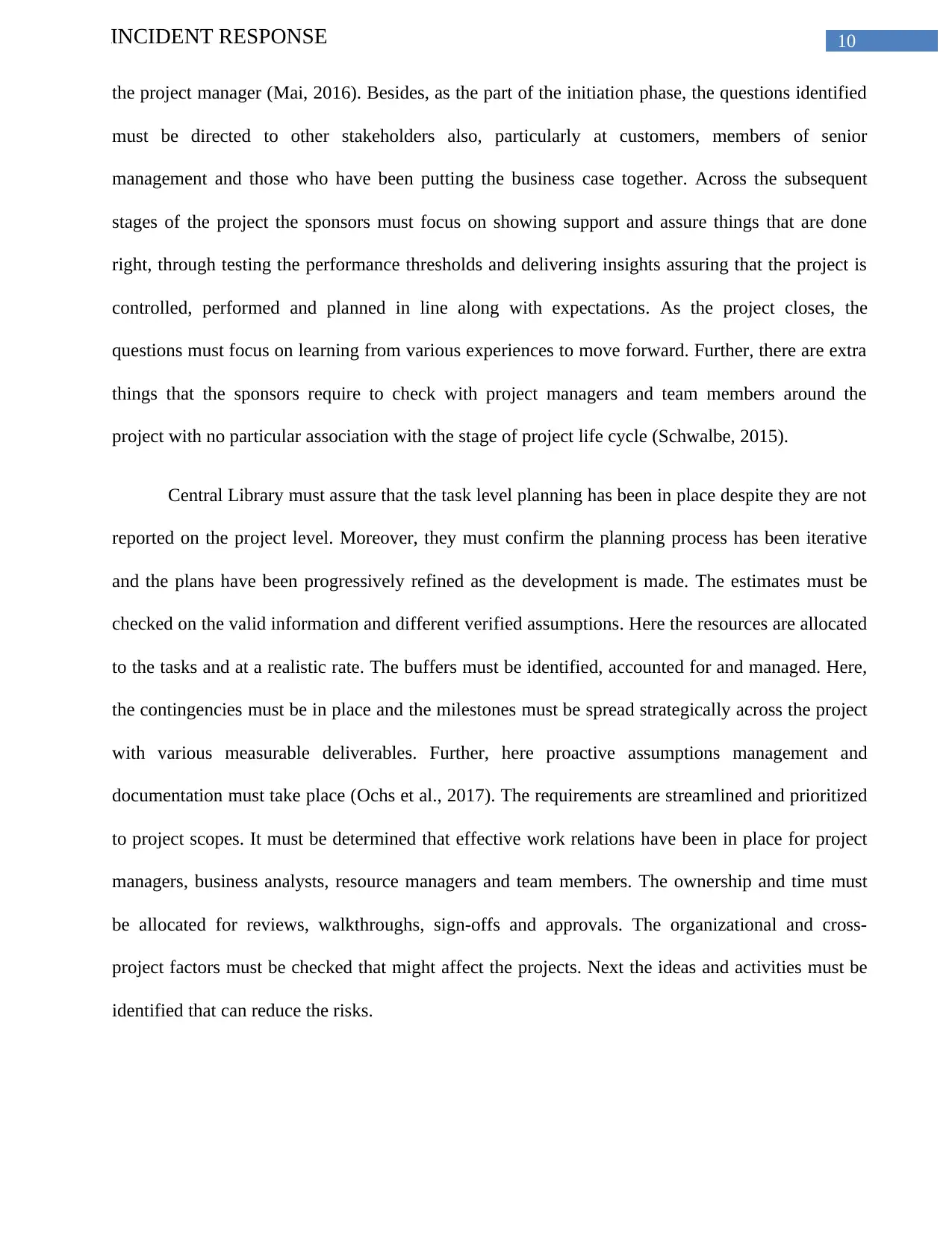
10INCIDENT RESPONSE
the project manager (Mai, 2016). Besides, as the part of the initiation phase, the questions identified
must be directed to other stakeholders also, particularly at customers, members of senior
management and those who have been putting the business case together. Across the subsequent
stages of the project the sponsors must focus on showing support and assure things that are done
right, through testing the performance thresholds and delivering insights assuring that the project is
controlled, performed and planned in line along with expectations. As the project closes, the
questions must focus on learning from various experiences to move forward. Further, there are extra
things that the sponsors require to check with project managers and team members around the
project with no particular association with the stage of project life cycle (Schwalbe, 2015).
Central Library must assure that the task level planning has been in place despite they are not
reported on the project level. Moreover, they must confirm the planning process has been iterative
and the plans have been progressively refined as the development is made. The estimates must be
checked on the valid information and different verified assumptions. Here the resources are allocated
to the tasks and at a realistic rate. The buffers must be identified, accounted for and managed. Here,
the contingencies must be in place and the milestones must be spread strategically across the project
with various measurable deliverables. Further, here proactive assumptions management and
documentation must take place (Ochs et al., 2017). The requirements are streamlined and prioritized
to project scopes. It must be determined that effective work relations have been in place for project
managers, business analysts, resource managers and team members. The ownership and time must
be allocated for reviews, walkthroughs, sign-offs and approvals. The organizational and cross-
project factors must be checked that might affect the projects. Next the ideas and activities must be
identified that can reduce the risks.
the project manager (Mai, 2016). Besides, as the part of the initiation phase, the questions identified
must be directed to other stakeholders also, particularly at customers, members of senior
management and those who have been putting the business case together. Across the subsequent
stages of the project the sponsors must focus on showing support and assure things that are done
right, through testing the performance thresholds and delivering insights assuring that the project is
controlled, performed and planned in line along with expectations. As the project closes, the
questions must focus on learning from various experiences to move forward. Further, there are extra
things that the sponsors require to check with project managers and team members around the
project with no particular association with the stage of project life cycle (Schwalbe, 2015).
Central Library must assure that the task level planning has been in place despite they are not
reported on the project level. Moreover, they must confirm the planning process has been iterative
and the plans have been progressively refined as the development is made. The estimates must be
checked on the valid information and different verified assumptions. Here the resources are allocated
to the tasks and at a realistic rate. The buffers must be identified, accounted for and managed. Here,
the contingencies must be in place and the milestones must be spread strategically across the project
with various measurable deliverables. Further, here proactive assumptions management and
documentation must take place (Ochs et al., 2017). The requirements are streamlined and prioritized
to project scopes. It must be determined that effective work relations have been in place for project
managers, business analysts, resource managers and team members. The ownership and time must
be allocated for reviews, walkthroughs, sign-offs and approvals. The organizational and cross-
project factors must be checked that might affect the projects. Next the ideas and activities must be
identified that can reduce the risks.
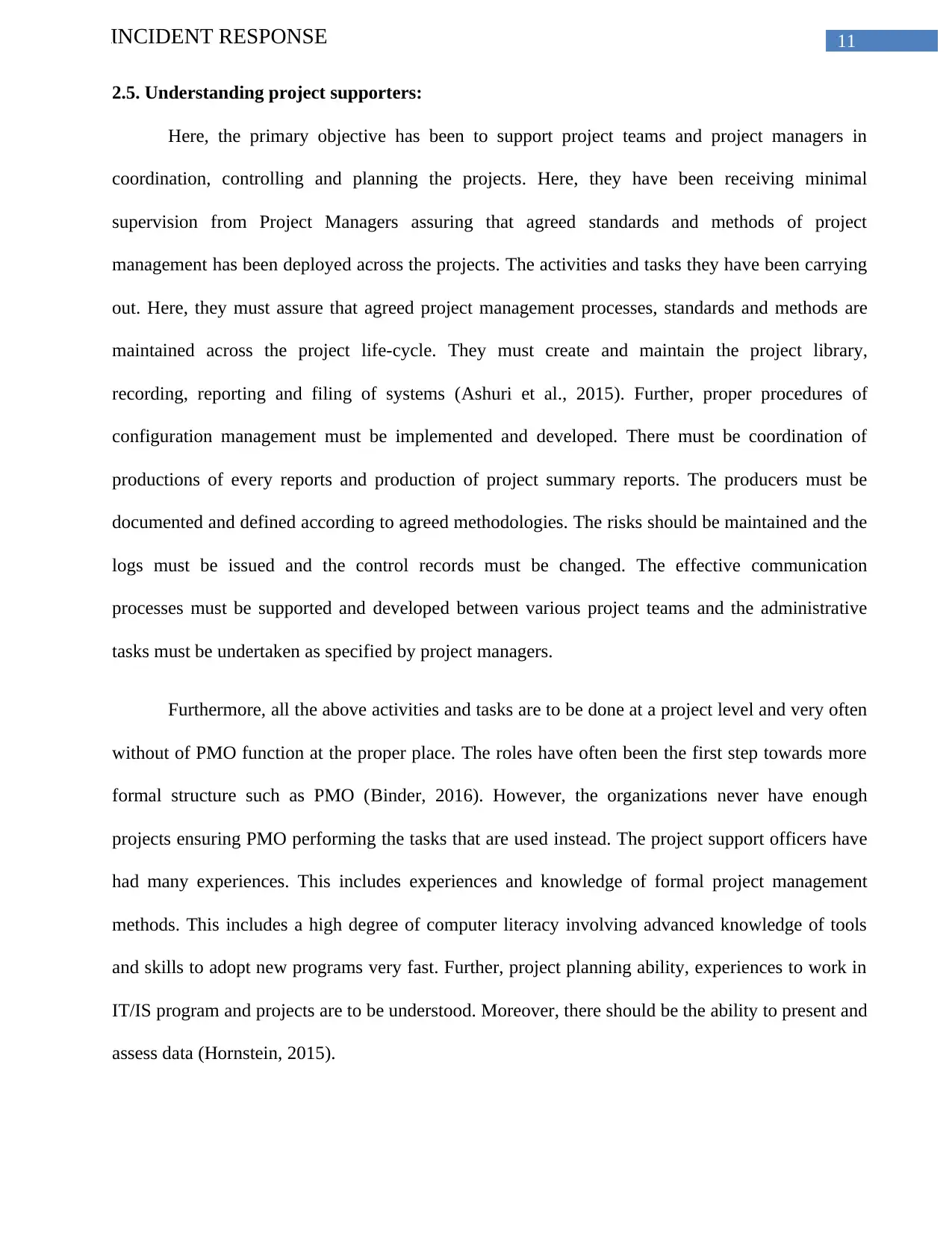
11INCIDENT RESPONSE
2.5. Understanding project supporters:
Here, the primary objective has been to support project teams and project managers in
coordination, controlling and planning the projects. Here, they have been receiving minimal
supervision from Project Managers assuring that agreed standards and methods of project
management has been deployed across the projects. The activities and tasks they have been carrying
out. Here, they must assure that agreed project management processes, standards and methods are
maintained across the project life-cycle. They must create and maintain the project library,
recording, reporting and filing of systems (Ashuri et al., 2015). Further, proper procedures of
configuration management must be implemented and developed. There must be coordination of
productions of every reports and production of project summary reports. The producers must be
documented and defined according to agreed methodologies. The risks should be maintained and the
logs must be issued and the control records must be changed. The effective communication
processes must be supported and developed between various project teams and the administrative
tasks must be undertaken as specified by project managers.
Furthermore, all the above activities and tasks are to be done at a project level and very often
without of PMO function at the proper place. The roles have often been the first step towards more
formal structure such as PMO (Binder, 2016). However, the organizations never have enough
projects ensuring PMO performing the tasks that are used instead. The project support officers have
had many experiences. This includes experiences and knowledge of formal project management
methods. This includes a high degree of computer literacy involving advanced knowledge of tools
and skills to adopt new programs very fast. Further, project planning ability, experiences to work in
IT/IS program and projects are to be understood. Moreover, there should be the ability to present and
assess data (Hornstein, 2015).
2.5. Understanding project supporters:
Here, the primary objective has been to support project teams and project managers in
coordination, controlling and planning the projects. Here, they have been receiving minimal
supervision from Project Managers assuring that agreed standards and methods of project
management has been deployed across the projects. The activities and tasks they have been carrying
out. Here, they must assure that agreed project management processes, standards and methods are
maintained across the project life-cycle. They must create and maintain the project library,
recording, reporting and filing of systems (Ashuri et al., 2015). Further, proper procedures of
configuration management must be implemented and developed. There must be coordination of
productions of every reports and production of project summary reports. The producers must be
documented and defined according to agreed methodologies. The risks should be maintained and the
logs must be issued and the control records must be changed. The effective communication
processes must be supported and developed between various project teams and the administrative
tasks must be undertaken as specified by project managers.
Furthermore, all the above activities and tasks are to be done at a project level and very often
without of PMO function at the proper place. The roles have often been the first step towards more
formal structure such as PMO (Binder, 2016). However, the organizations never have enough
projects ensuring PMO performing the tasks that are used instead. The project support officers have
had many experiences. This includes experiences and knowledge of formal project management
methods. This includes a high degree of computer literacy involving advanced knowledge of tools
and skills to adopt new programs very fast. Further, project planning ability, experiences to work in
IT/IS program and projects are to be understood. Moreover, there should be the ability to present and
assess data (Hornstein, 2015).
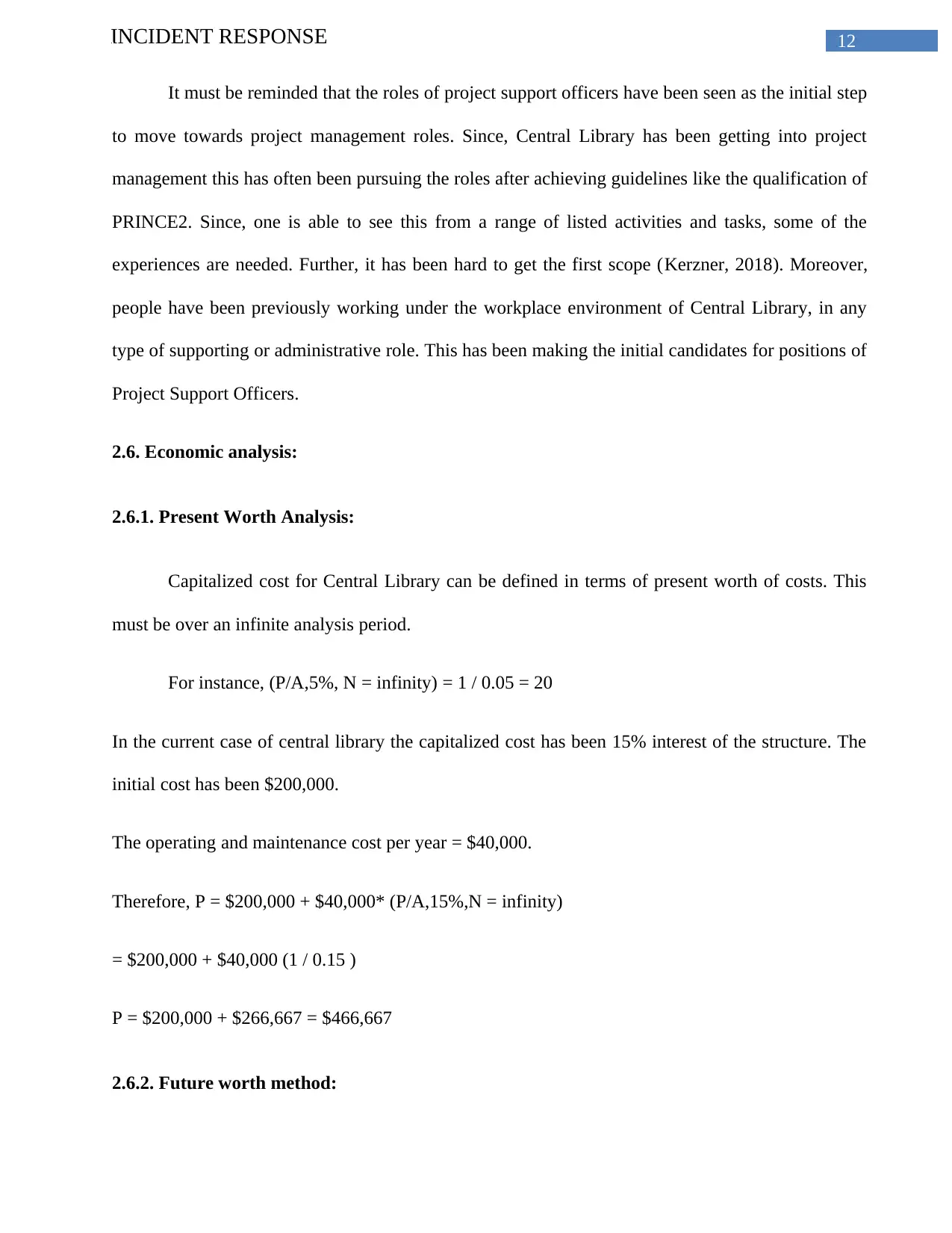
12INCIDENT RESPONSE
It must be reminded that the roles of project support officers have been seen as the initial step
to move towards project management roles. Since, Central Library has been getting into project
management this has often been pursuing the roles after achieving guidelines like the qualification of
PRINCE2. Since, one is able to see this from a range of listed activities and tasks, some of the
experiences are needed. Further, it has been hard to get the first scope (Kerzner, 2018). Moreover,
people have been previously working under the workplace environment of Central Library, in any
type of supporting or administrative role. This has been making the initial candidates for positions of
Project Support Officers.
2.6. Economic analysis:
2.6.1. Present Worth Analysis:
Capitalized cost for Central Library can be defined in terms of present worth of costs. This
must be over an infinite analysis period.
For instance, (P/A,5%, N = infinity) = 1 / 0.05 = 20
In the current case of central library the capitalized cost has been 15% interest of the structure. The
initial cost has been $200,000.
The operating and maintenance cost per year = $40,000.
Therefore, P = $200,000 + $40,000* (P/A,15%,N = infinity)
= $200,000 + $40,000 (1 / 0.15 )
P = $200,000 + $266,667 = $466,667
2.6.2. Future worth method:
It must be reminded that the roles of project support officers have been seen as the initial step
to move towards project management roles. Since, Central Library has been getting into project
management this has often been pursuing the roles after achieving guidelines like the qualification of
PRINCE2. Since, one is able to see this from a range of listed activities and tasks, some of the
experiences are needed. Further, it has been hard to get the first scope (Kerzner, 2018). Moreover,
people have been previously working under the workplace environment of Central Library, in any
type of supporting or administrative role. This has been making the initial candidates for positions of
Project Support Officers.
2.6. Economic analysis:
2.6.1. Present Worth Analysis:
Capitalized cost for Central Library can be defined in terms of present worth of costs. This
must be over an infinite analysis period.
For instance, (P/A,5%, N = infinity) = 1 / 0.05 = 20
In the current case of central library the capitalized cost has been 15% interest of the structure. The
initial cost has been $200,000.
The operating and maintenance cost per year = $40,000.
Therefore, P = $200,000 + $40,000* (P/A,15%,N = infinity)
= $200,000 + $40,000 (1 / 0.15 )
P = $200,000 + $266,667 = $466,667
2.6.2. Future worth method:
Paraphrase This Document
Need a fresh take? Get an instant paraphrase of this document with our AI Paraphraser
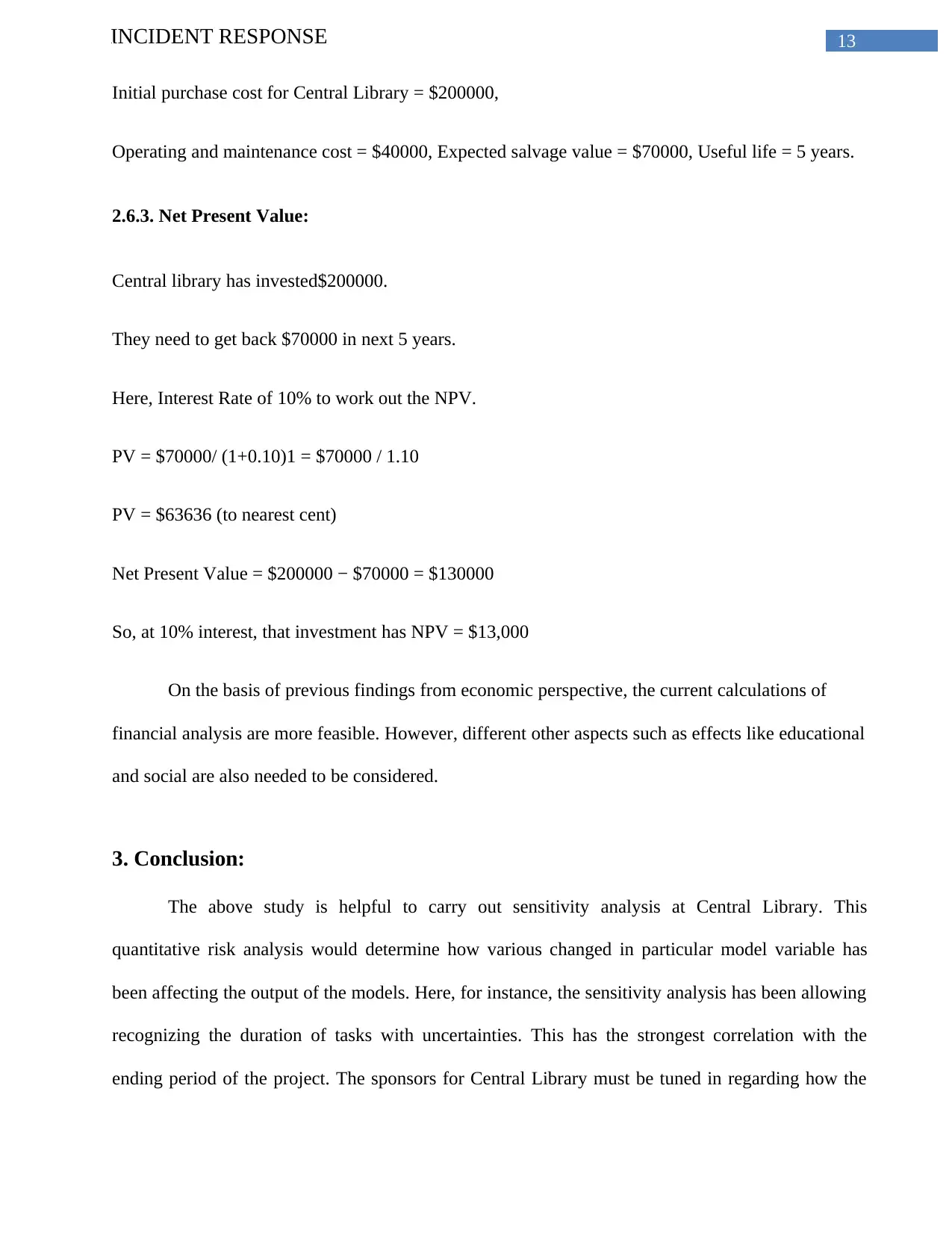
13INCIDENT RESPONSE
Initial purchase cost for Central Library = $200000,
Operating and maintenance cost = $40000, Expected salvage value = $70000, Useful life = 5 years.
2.6.3. Net Present Value:
Central library has invested$200000.
They need to get back $70000 in next 5 years.
Here, Interest Rate of 10% to work out the NPV.
PV = $70000/ (1+0.10)1 = $70000 / 1.10
PV = $63636 (to nearest cent)
Net Present Value = $200000 − $70000 = $130000
So, at 10% interest, that investment has NPV = $13,000
On the basis of previous findings from economic perspective, the current calculations of
financial analysis are more feasible. However, different other aspects such as effects like educational
and social are also needed to be considered.
3. Conclusion:
The above study is helpful to carry out sensitivity analysis at Central Library. This
quantitative risk analysis would determine how various changed in particular model variable has
been affecting the output of the models. Here, for instance, the sensitivity analysis has been allowing
recognizing the duration of tasks with uncertainties. This has the strongest correlation with the
ending period of the project. The sponsors for Central Library must be tuned in regarding how the
Initial purchase cost for Central Library = $200000,
Operating and maintenance cost = $40000, Expected salvage value = $70000, Useful life = 5 years.
2.6.3. Net Present Value:
Central library has invested$200000.
They need to get back $70000 in next 5 years.
Here, Interest Rate of 10% to work out the NPV.
PV = $70000/ (1+0.10)1 = $70000 / 1.10
PV = $63636 (to nearest cent)
Net Present Value = $200000 − $70000 = $130000
So, at 10% interest, that investment has NPV = $13,000
On the basis of previous findings from economic perspective, the current calculations of
financial analysis are more feasible. However, different other aspects such as effects like educational
and social are also needed to be considered.
3. Conclusion:
The above study is helpful to carry out sensitivity analysis at Central Library. This
quantitative risk analysis would determine how various changed in particular model variable has
been affecting the output of the models. Here, for instance, the sensitivity analysis has been allowing
recognizing the duration of tasks with uncertainties. This has the strongest correlation with the
ending period of the project. The sponsors for Central Library must be tuned in regarding how the
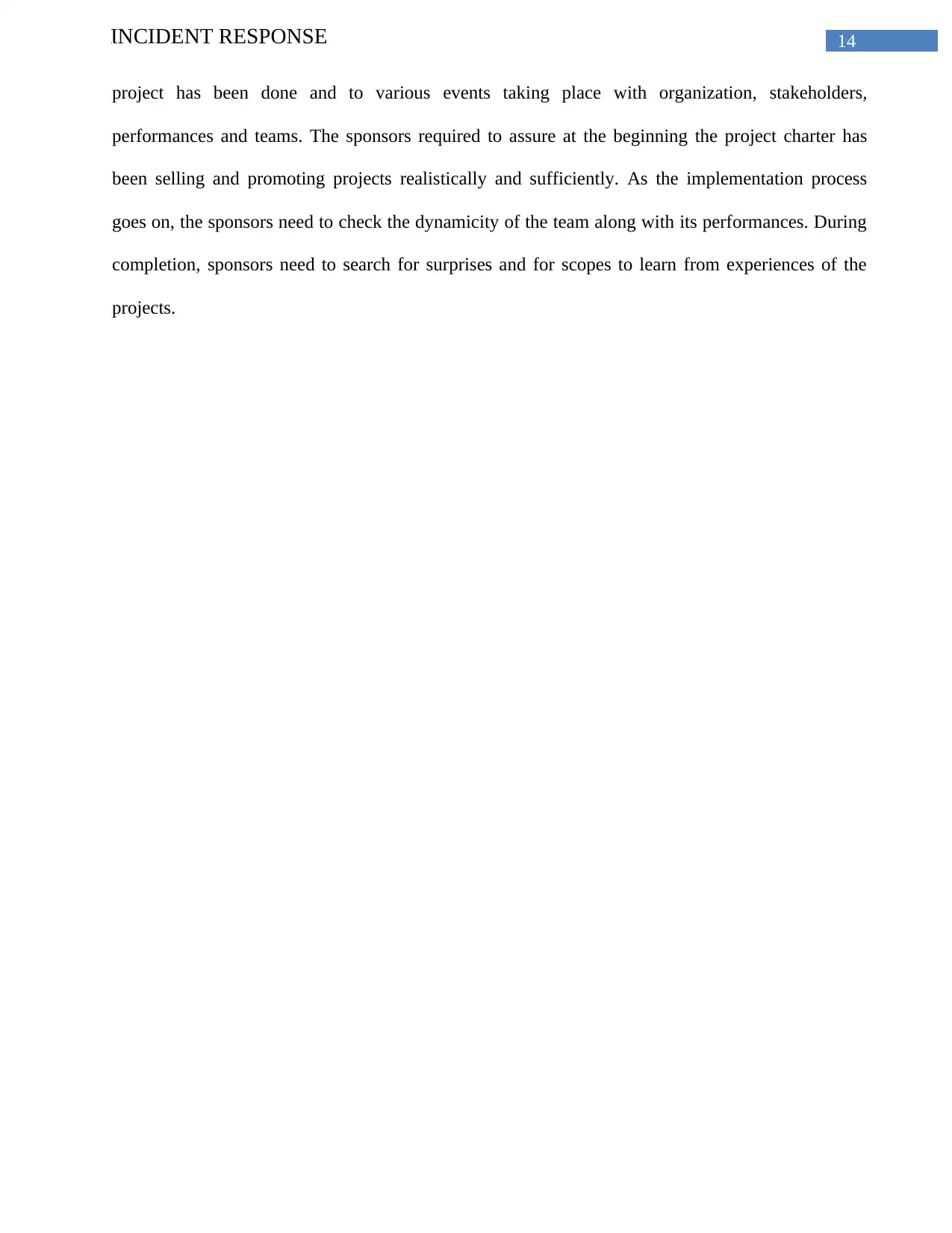
14INCIDENT RESPONSE
project has been done and to various events taking place with organization, stakeholders,
performances and teams. The sponsors required to assure at the beginning the project charter has
been selling and promoting projects realistically and sufficiently. As the implementation process
goes on, the sponsors need to check the dynamicity of the team along with its performances. During
completion, sponsors need to search for surprises and for scopes to learn from experiences of the
projects.
project has been done and to various events taking place with organization, stakeholders,
performances and teams. The sponsors required to assure at the beginning the project charter has
been selling and promoting projects realistically and sufficiently. As the implementation process
goes on, the sponsors need to check the dynamicity of the team along with its performances. During
completion, sponsors need to search for surprises and for scopes to learn from experiences of the
projects.
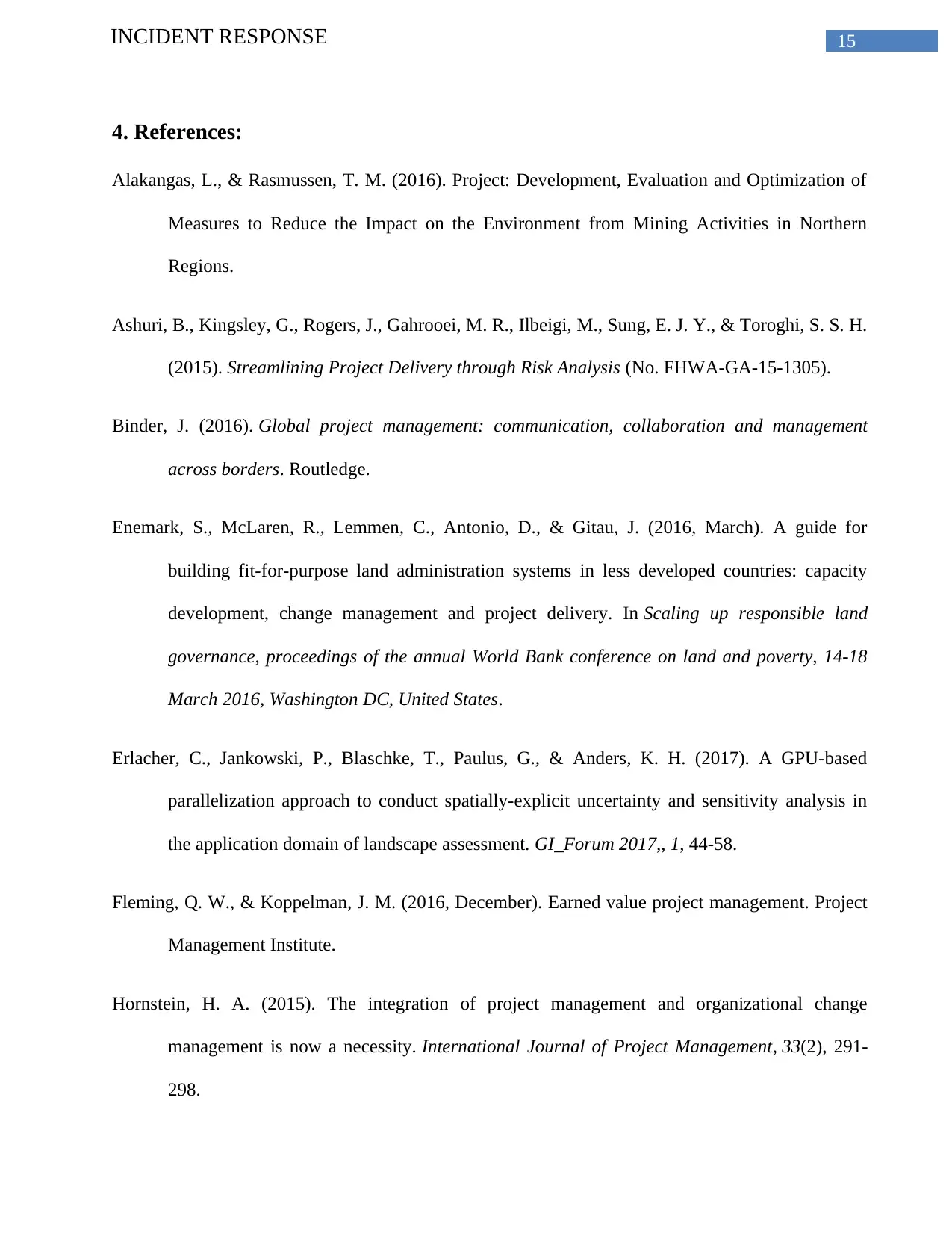
15INCIDENT RESPONSE
4. References:
Alakangas, L., & Rasmussen, T. M. (2016). Project: Development, Evaluation and Optimization of
Measures to Reduce the Impact on the Environment from Mining Activities in Northern
Regions.
Ashuri, B., Kingsley, G., Rogers, J., Gahrooei, M. R., Ilbeigi, M., Sung, E. J. Y., & Toroghi, S. S. H.
(2015). Streamlining Project Delivery through Risk Analysis (No. FHWA-GA-15-1305).
Binder, J. (2016). Global project management: communication, collaboration and management
across borders. Routledge.
Enemark, S., McLaren, R., Lemmen, C., Antonio, D., & Gitau, J. (2016, March). A guide for
building fit-for-purpose land administration systems in less developed countries: capacity
development, change management and project delivery. In Scaling up responsible land
governance, proceedings of the annual World Bank conference on land and poverty, 14-18
March 2016, Washington DC, United States.
Erlacher, C., Jankowski, P., Blaschke, T., Paulus, G., & Anders, K. H. (2017). A GPU-based
parallelization approach to conduct spatially-explicit uncertainty and sensitivity analysis in
the application domain of landscape assessment. GI_Forum 2017,, 1, 44-58.
Fleming, Q. W., & Koppelman, J. M. (2016, December). Earned value project management. Project
Management Institute.
Hornstein, H. A. (2015). The integration of project management and organizational change
management is now a necessity. International Journal of Project Management, 33(2), 291-
298.
4. References:
Alakangas, L., & Rasmussen, T. M. (2016). Project: Development, Evaluation and Optimization of
Measures to Reduce the Impact on the Environment from Mining Activities in Northern
Regions.
Ashuri, B., Kingsley, G., Rogers, J., Gahrooei, M. R., Ilbeigi, M., Sung, E. J. Y., & Toroghi, S. S. H.
(2015). Streamlining Project Delivery through Risk Analysis (No. FHWA-GA-15-1305).
Binder, J. (2016). Global project management: communication, collaboration and management
across borders. Routledge.
Enemark, S., McLaren, R., Lemmen, C., Antonio, D., & Gitau, J. (2016, March). A guide for
building fit-for-purpose land administration systems in less developed countries: capacity
development, change management and project delivery. In Scaling up responsible land
governance, proceedings of the annual World Bank conference on land and poverty, 14-18
March 2016, Washington DC, United States.
Erlacher, C., Jankowski, P., Blaschke, T., Paulus, G., & Anders, K. H. (2017). A GPU-based
parallelization approach to conduct spatially-explicit uncertainty and sensitivity analysis in
the application domain of landscape assessment. GI_Forum 2017,, 1, 44-58.
Fleming, Q. W., & Koppelman, J. M. (2016, December). Earned value project management. Project
Management Institute.
Hornstein, H. A. (2015). The integration of project management and organizational change
management is now a necessity. International Journal of Project Management, 33(2), 291-
298.
Secure Best Marks with AI Grader
Need help grading? Try our AI Grader for instant feedback on your assignments.
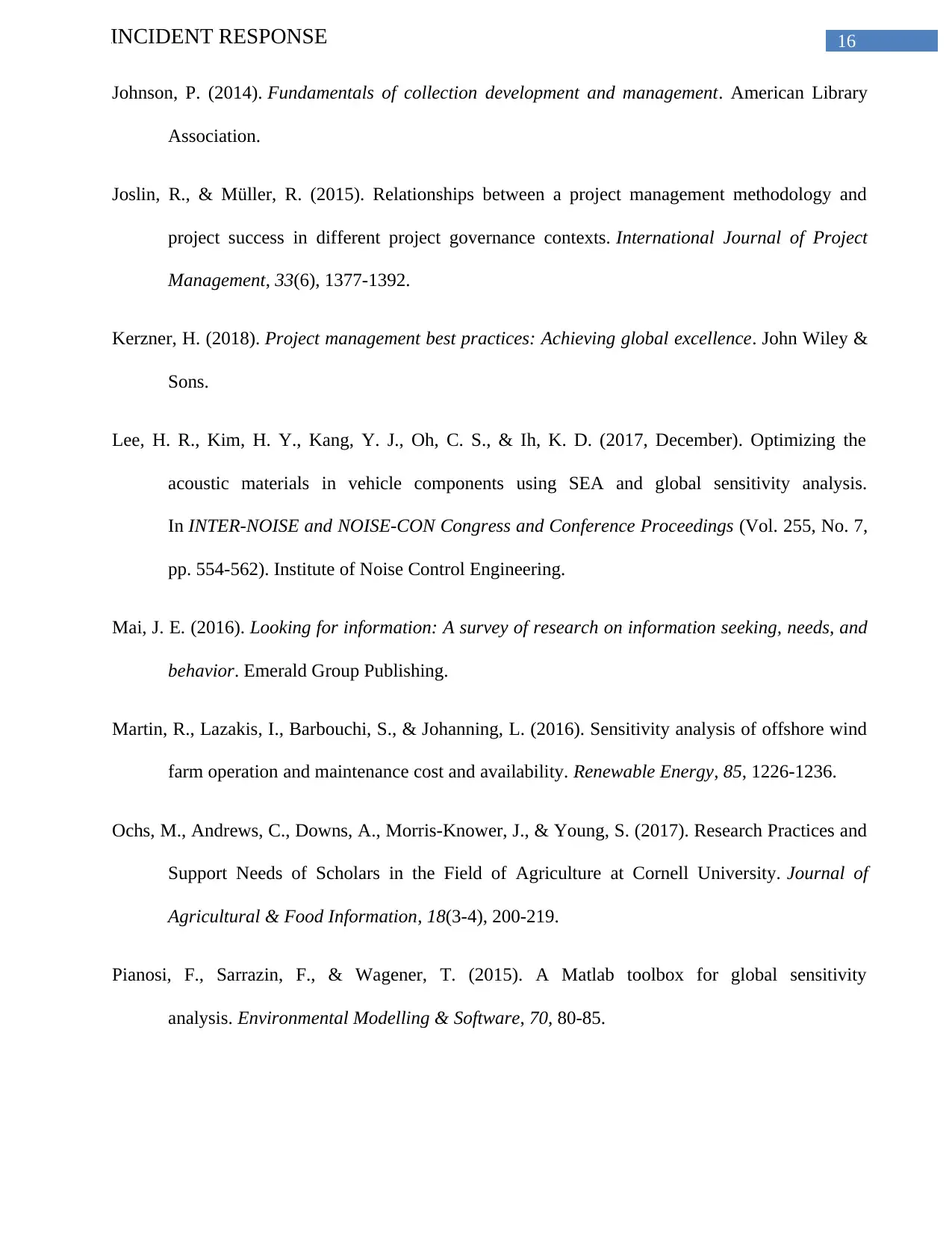
16INCIDENT RESPONSE
Johnson, P. (2014). Fundamentals of collection development and management. American Library
Association.
Joslin, R., & Müller, R. (2015). Relationships between a project management methodology and
project success in different project governance contexts. International Journal of Project
Management, 33(6), 1377-1392.
Kerzner, H. (2018). Project management best practices: Achieving global excellence. John Wiley &
Sons.
Lee, H. R., Kim, H. Y., Kang, Y. J., Oh, C. S., & Ih, K. D. (2017, December). Optimizing the
acoustic materials in vehicle components using SEA and global sensitivity analysis.
In INTER-NOISE and NOISE-CON Congress and Conference Proceedings (Vol. 255, No. 7,
pp. 554-562). Institute of Noise Control Engineering.
Mai, J. E. (2016). Looking for information: A survey of research on information seeking, needs, and
behavior. Emerald Group Publishing.
Martin, R., Lazakis, I., Barbouchi, S., & Johanning, L. (2016). Sensitivity analysis of offshore wind
farm operation and maintenance cost and availability. Renewable Energy, 85, 1226-1236.
Ochs, M., Andrews, C., Downs, A., Morris-Knower, J., & Young, S. (2017). Research Practices and
Support Needs of Scholars in the Field of Agriculture at Cornell University. Journal of
Agricultural & Food Information, 18(3-4), 200-219.
Pianosi, F., Sarrazin, F., & Wagener, T. (2015). A Matlab toolbox for global sensitivity
analysis. Environmental Modelling & Software, 70, 80-85.
Johnson, P. (2014). Fundamentals of collection development and management. American Library
Association.
Joslin, R., & Müller, R. (2015). Relationships between a project management methodology and
project success in different project governance contexts. International Journal of Project
Management, 33(6), 1377-1392.
Kerzner, H. (2018). Project management best practices: Achieving global excellence. John Wiley &
Sons.
Lee, H. R., Kim, H. Y., Kang, Y. J., Oh, C. S., & Ih, K. D. (2017, December). Optimizing the
acoustic materials in vehicle components using SEA and global sensitivity analysis.
In INTER-NOISE and NOISE-CON Congress and Conference Proceedings (Vol. 255, No. 7,
pp. 554-562). Institute of Noise Control Engineering.
Mai, J. E. (2016). Looking for information: A survey of research on information seeking, needs, and
behavior. Emerald Group Publishing.
Martin, R., Lazakis, I., Barbouchi, S., & Johanning, L. (2016). Sensitivity analysis of offshore wind
farm operation and maintenance cost and availability. Renewable Energy, 85, 1226-1236.
Ochs, M., Andrews, C., Downs, A., Morris-Knower, J., & Young, S. (2017). Research Practices and
Support Needs of Scholars in the Field of Agriculture at Cornell University. Journal of
Agricultural & Food Information, 18(3-4), 200-219.
Pianosi, F., Sarrazin, F., & Wagener, T. (2015). A Matlab toolbox for global sensitivity
analysis. Environmental Modelling & Software, 70, 80-85.
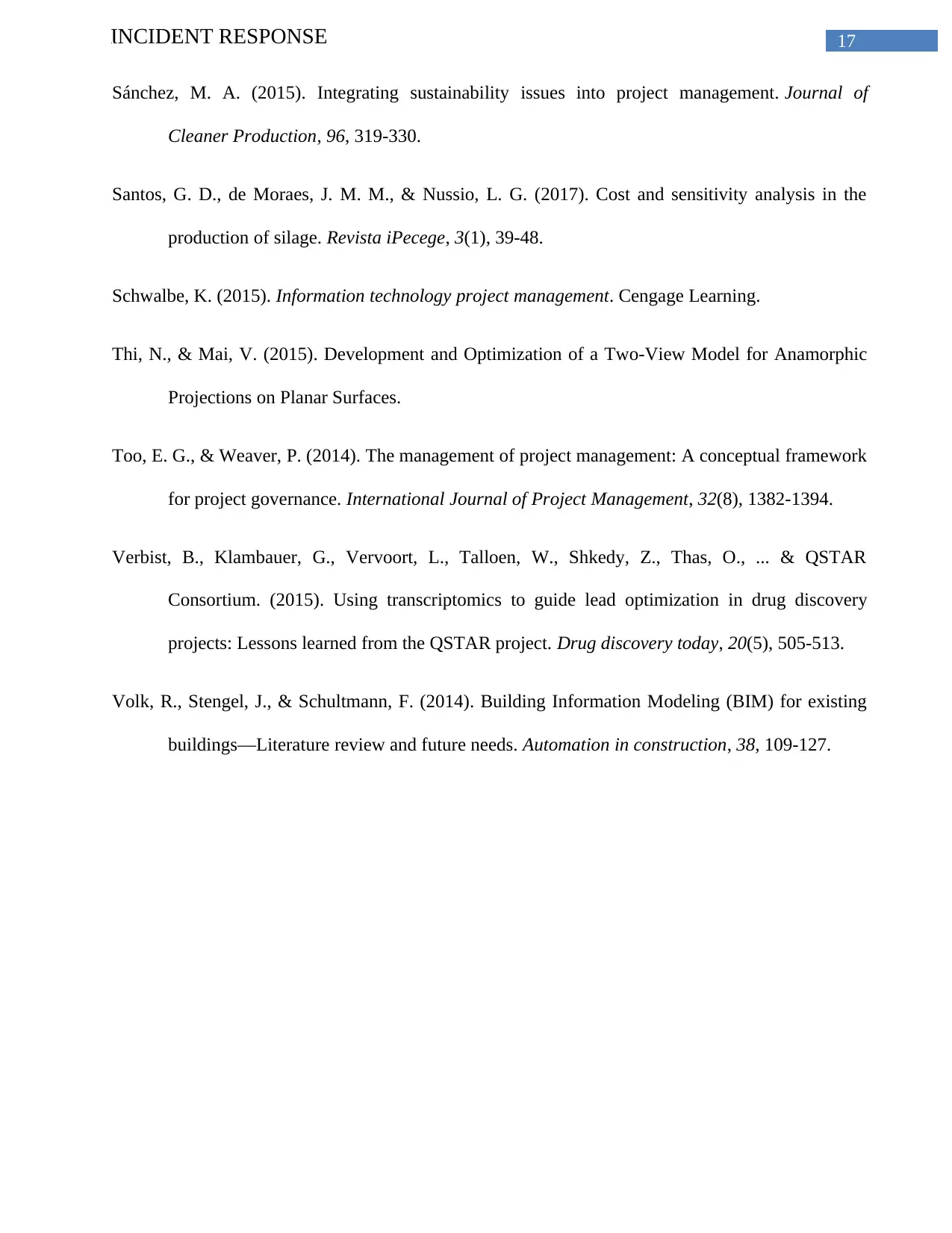
17INCIDENT RESPONSE
Sánchez, M. A. (2015). Integrating sustainability issues into project management. Journal of
Cleaner Production, 96, 319-330.
Santos, G. D., de Moraes, J. M. M., & Nussio, L. G. (2017). Cost and sensitivity analysis in the
production of silage. Revista iPecege, 3(1), 39-48.
Schwalbe, K. (2015). Information technology project management. Cengage Learning.
Thi, N., & Mai, V. (2015). Development and Optimization of a Two-View Model for Anamorphic
Projections on Planar Surfaces.
Too, E. G., & Weaver, P. (2014). The management of project management: A conceptual framework
for project governance. International Journal of Project Management, 32(8), 1382-1394.
Verbist, B., Klambauer, G., Vervoort, L., Talloen, W., Shkedy, Z., Thas, O., ... & QSTAR
Consortium. (2015). Using transcriptomics to guide lead optimization in drug discovery
projects: Lessons learned from the QSTAR project. Drug discovery today, 20(5), 505-513.
Volk, R., Stengel, J., & Schultmann, F. (2014). Building Information Modeling (BIM) for existing
buildings—Literature review and future needs. Automation in construction, 38, 109-127.
Sánchez, M. A. (2015). Integrating sustainability issues into project management. Journal of
Cleaner Production, 96, 319-330.
Santos, G. D., de Moraes, J. M. M., & Nussio, L. G. (2017). Cost and sensitivity analysis in the
production of silage. Revista iPecege, 3(1), 39-48.
Schwalbe, K. (2015). Information technology project management. Cengage Learning.
Thi, N., & Mai, V. (2015). Development and Optimization of a Two-View Model for Anamorphic
Projections on Planar Surfaces.
Too, E. G., & Weaver, P. (2014). The management of project management: A conceptual framework
for project governance. International Journal of Project Management, 32(8), 1382-1394.
Verbist, B., Klambauer, G., Vervoort, L., Talloen, W., Shkedy, Z., Thas, O., ... & QSTAR
Consortium. (2015). Using transcriptomics to guide lead optimization in drug discovery
projects: Lessons learned from the QSTAR project. Drug discovery today, 20(5), 505-513.
Volk, R., Stengel, J., & Schultmann, F. (2014). Building Information Modeling (BIM) for existing
buildings—Literature review and future needs. Automation in construction, 38, 109-127.
1 out of 18
Related Documents
Your All-in-One AI-Powered Toolkit for Academic Success.
+13062052269
info@desklib.com
Available 24*7 on WhatsApp / Email
![[object Object]](/_next/static/media/star-bottom.7253800d.svg)
Unlock your academic potential
© 2024 | Zucol Services PVT LTD | All rights reserved.





